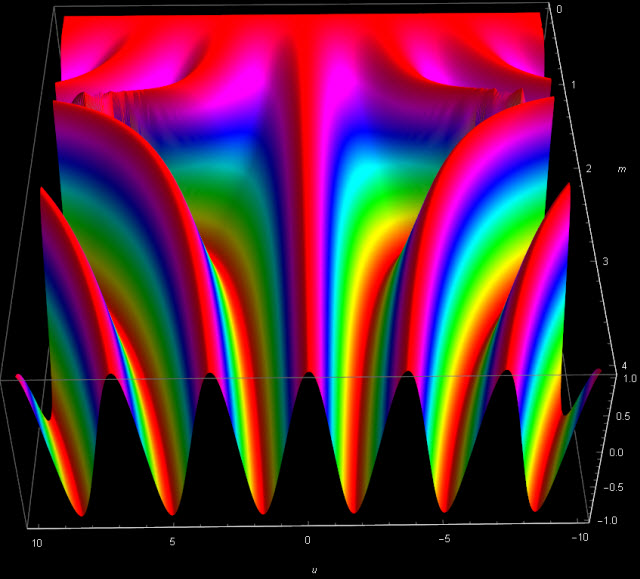Before moving to imaginary time let us warm ourselves up first doing a small exercise while still in real time. We did not quite finish our business with periods of elliptic functions in the last post “Periods of Jacobi elliptic functions – Part 1.” We did not answer the question: what about the periods for ![]() ?
?
We know (see The case of inverted modulus – Treading on Tiger’s tail and Jacobi elliptic cn and dn) that for ![]() we have the formulas
we have the formulas
(1) 
We know, from Periods of Jacobi elliptic functions – Part 1, that the period of ![]() for
for ![]() is
is ![]() Therefore, from Eq. (1) we deduce that the period of
Therefore, from Eq. (1) we deduce that the period of ![]() for
for ![]() is
is ![]() For instance, we have
For instance, we have ![]() But in the previous post we have shown that for
But in the previous post we have shown that for ![]() we have
we have
(2) ![]()
Therefore, for ![]() the period of
the period of ![]() is
is ![]() From two last equations in (1) we see that, for
From two last equations in (1) we see that, for ![]() , the period for
, the period for ![]() is the same as that of
is the same as that of ![]() , and the period of
, and the period of ![]() is half of that.
is half of that.
Below is the plot of the function ![]() that shows its periodicity.
that shows its periodicity.

Plot of  for
for  and
and 
 After these warm-up exercises we now open the door to the universe with the imaginary time. In fact there are several different doors leading there, and we will choose one that has been used by Alfred Cardew Dixon, MA, in his 1894 book “The Elementary Properties of the Elliptic Functions with Examples“.
After these warm-up exercises we now open the door to the universe with the imaginary time. In fact there are several different doors leading there, and we will choose one that has been used by Alfred Cardew Dixon, MA, in his 1894 book “The Elementary Properties of the Elliptic Functions with Examples“.
Namely, we take the Eqs. (1)-(4) from Periods of Jacobi elliptic functions – Part 1 as the defining relations of the Jacobi elliptic functions.
In other words: whenever we have three functions ![]() and a constant
and a constant ![]() satisfying
satisfying
(3) ![]()
(4) ![]()
(5) ![]()
(6) ![]()
(7) ![]()
We are now ready for the trick invented by Jacobi, called “Jacobi Imaginary Transformation“. But before that, once we are in the land of elliptic functions, let us familiarize ourselves with the language used by some of the native population of this country. Following one Dr. Glaisher, the following notation is sometimes used in conversations in local pubs:
![]()
![]()
![]()
Now we are really ready.
It is a question of simple rules about derivatives of fractions and a simple algebra (we can use REDUCE to this end) to establish the following properties:
(8) ![]()
(9) ![]()
(10) ![]()
Here is the REDUCE code checking these relations – it produces, on output, three zeros.:
For all u let sc(u)=sn(u)/cn(u);
For all u let dc(u)=dn(u)/cn(u);
For all u let nc(u)=1/cn(u);
For all u let DF(sn(u),u)=cn(u)*dn(u);
For all v let DF(cn(v),v)=-sn(v)*dn(v);
For all v let DF(dn(v),v)=-k2*sn(v)*cn(v);
For all u let cn(u)^2=1-sn(u)^2;
For all u let dn(u)^2=1-k2*sn(u)^2;
kp2:=1-k2;
l1:=DF(sc(u),u)-dc(u)*nc(u);
l2:=nc(u)^2-sc(u)^2-1;
l3:=dc(u)^2-kp2*sc(u)^2-1;
END;
Comparing Eqs. (8–10) with (3–5) we notice that if we set
![]()
,
then, since ![]() we must have
we must have ![]() Therefore
Therefore
![]()
![]()
![]() Bu since the relation between
Bu since the relation between ![]() and
and ![]() is symmetric, we can as well write
is symmetric, we can as well write
(11) 
The functions on the right hand side have the period ![]() denoted simply as
denoted simply as ![]() . Therefore the function on the left hand side have the period
. Therefore the function on the left hand side have the period ![]() We can use now addition formula and
We can use now addition formula and
calculate the functions ![]() for any complex
for any complex ![]() The period along the real direction is
The period along the real direction is ![]() the period along the imaginary direction is
the period along the imaginary direction is ![]()

Plot of of the absolute value of  for
for  We have
We have  ,
, 
Now we can navigate with ease in our complex times. In real time and in imaginary time.






